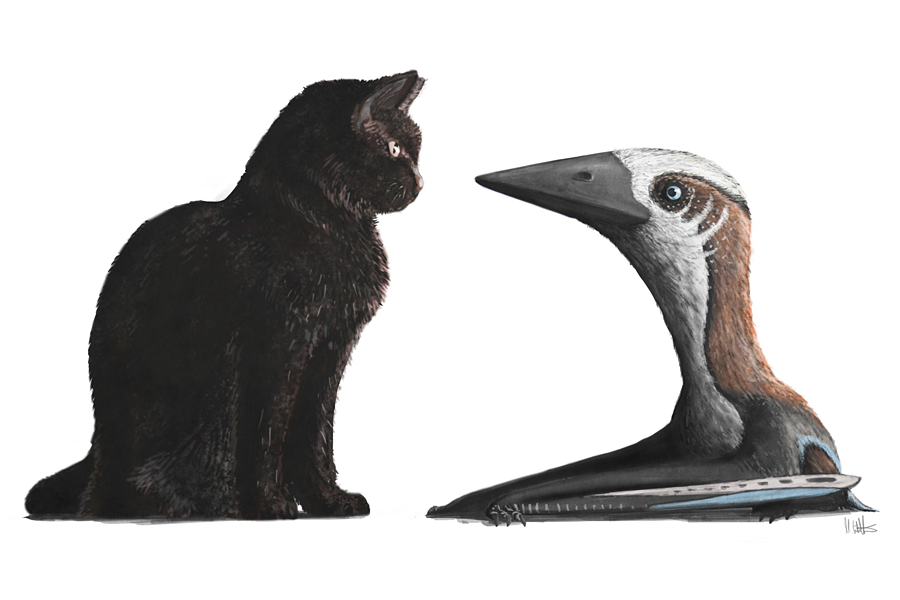Was this flying critter the ptiniest pterosaur of the Late Cretaceous?
Loading...
The largest flying animal known to soar this Earth was a pterosaur. With a wingspan of more than 32 feet, Quetzalcoatlus northropi dominated the skies at the end of the Late Cretaceous, the last days of the Age of the Dinosaurs.
But the humongous flying beast may have lived alongside a much tinier cousin. A 77-million-year-old fossil unearthed on Hornby Island in British Columbia, Canada, reveals what may have been the smallest pterosaur to soar in the Late Cretaceous skies.
This tiny pterosaur had a wingspan of just under 5 feet, according to the description of the new fossil published Tuesday in the journal Royal Society Open Science.
The new individual would have been dwarfed by most of the other pterosaurs known from the time. The smallest pterosaurs known from the Late Cretaceous had a wingspan of about 8 feet, comparable to those of the largest birds today. But the largest pterosaurs, including Quetzalcoatlus, would have stood as tall as a giraffe.
"We have this small pterosaur, which is in a time when there aren't meant to be any small pterosaurs," study co-author Mark Witton, a paleontologist at the University of Portsmouth in England, tells The Christian Science Monitor.
One of the things scientists ask when they find a surprisingly small animal is whether or not it's a juvenile, Dr. Witton says. So the team probed the microscopic anatomy of the pterosaur's bones to see if it was done growing when it died.
This pterosaur might have had a little bit of growing left to do, Witton says, but it was likely close to its full, adult size. And that means they had their hands on a special specimen.
"Pterosaurs are rare. Pterosaurs at the end of the Cretaceous, where they found their specimen, are even rarer. And smaller pterosaurs, small individuals, are more rare than that," Alexander Kellner, a paleontologist and pterosaur expert at the National Museum of the Federal University of Rio de Janeiro who was not part of the study, tells the Monitor.
But had this animal lived earlier, it might not have stood out as much. Similarly sized pterosaurs soared through most of the Mesozoic era, Witton says. "It's just at the Late Cretaceous where things get a bit weird."
Why don't paleontologists see the smaller pterosaurs continuing along in the fossil record alongside their larger cousins into the Late Cretaceous?
"One option is that they genuinely weren't there," Witton says.
"People have said that maybe the rise of birds is the problem here. Birds appear in the Jurassic period, they diversify, and they become a very successful group in their own right," he explains. "There's an idea that pterosaurs may have been out-competed by small birds."
In other words, birds ousted small-bodied pterosaurs from the ecological niche for small, flying animals.
But neither Witton nor Dr. Kellner buy it.
Instead, both scientists agree that there is probably just a preservation bias at work. Small-bodied pterosaurs may not have preserved well in the Late Cretaceous fossil record, for whatever reason, says Witton.
"We think that there's good evidence for this because we're not finding juveniles," he adds. Even the largest pterosaurs must have been small-bodied at one point in their lifespans, and they probably didn't all survive to adulthood, so these smaller pterosaur bones may simply preserve poorly.
And this new discovery supports the idea that small-bodied pterosaurs were indeed around during the Late Cretaceous, Witton says. So perhaps "the Late Cretaceous was not as unusual as we've been thinking it may have been."
This fossil doesn't reveal much more about pterosaurs, Witton says. It's not a complete skeleton. "You don't look at this thing and go, wow, that's the nicest thing you've ever seen," he says. "It really looks like it's been chewed up," and some of Witton's colleagues joked that it looked like a piece of rubble.
The research team has studied the scraps they have to try to place this individual pterosaur in a clade.
"We think that it's an Azhdarchoid pterosaur," Witton says. "These are things with big heads and relatively short wings. They were probably generalist feeders that spent much of their time walking around on the ground, basically eating whatever they could."
That would make it a particularly close cousin to the humongous Quetzalcoatlus northropi. But Kellner isn't convinced by that placement on the pterosaur family tree.
"The material they have is just very incomplete," he says. "I just don't think that they have enough material to be able to make a solid identification as to which pterosaur group those bones belong."
Regardless of where the new fossil falls phylogenetically, he says, "they undoubtedly have a small pterosaur species."









